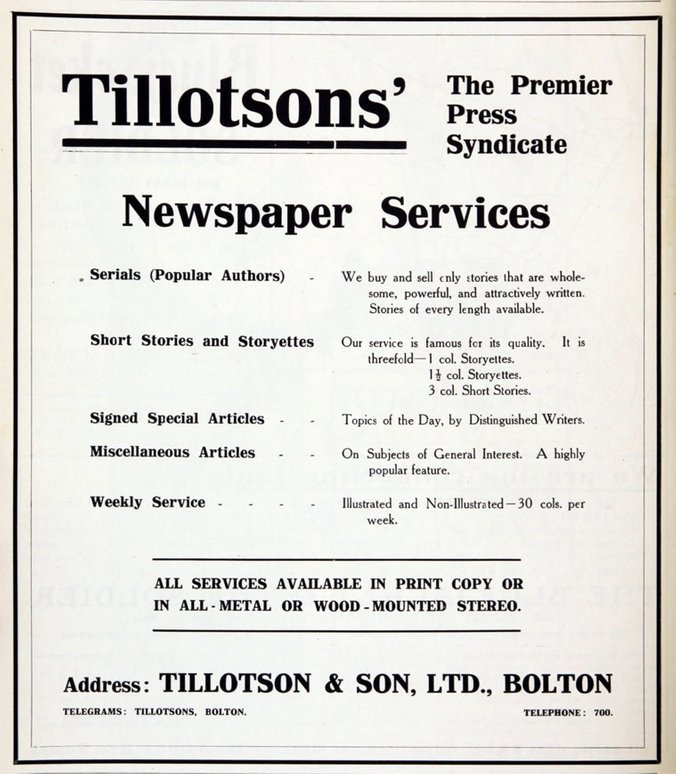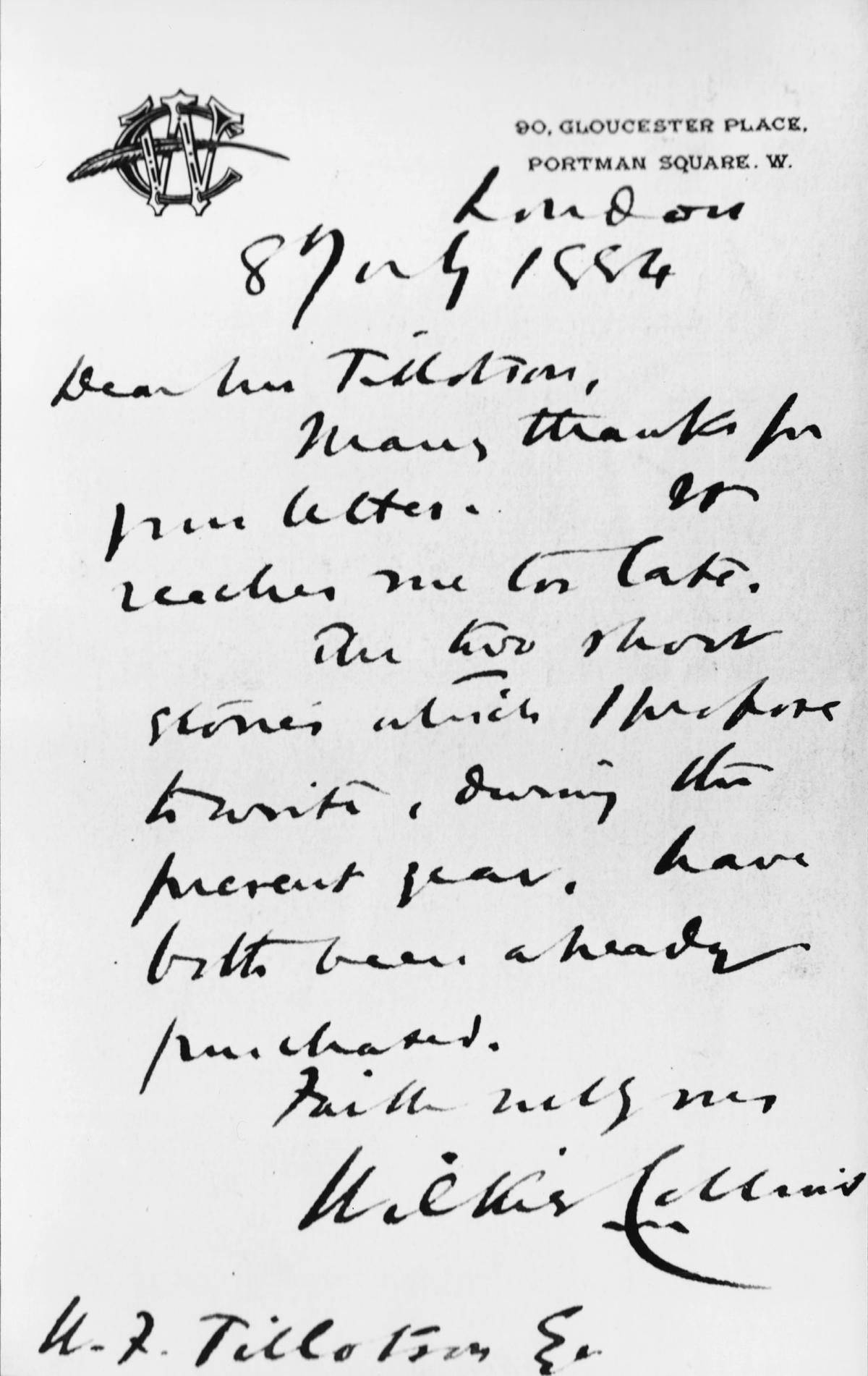This blog post examines the origins of the Bolton Weekly Journal's Tillotson Fiction Bureau established in 1873, informed by Colby, Hilliard, Johanningsmeier, Jones, and Singleton cited in the bibliography below.
When William Frederick Tillotson persuaded his printer father, John Tillotson, to publish the first edition of the Bolton Evening News on 19th March 1867, the young publishing entrepreneur became an early pioneer of the daily, local newspaper. In 1871, he began to publish a local weekly paper, recycling much of the copy from the B.E.N. but also including new material. To boost circulation, Tillotson negotiated with popular novelists of the day for the rights to serialise original work in what became the Bolton Weekly Journal, including figures such as Mary Elizabeth Braddon, Wilkie Collins, Rider Haggard and Thomas Hardy. Although novels had been serialised in French newspapers since 1836, Tillotson was amongst the first in England to see the commercial potential of syndicated fiction. The costs, however, of commissioning work from leading novelists led Tillotson to generate further revenue by selling publication rights to other provincial newspapers. The Tillotson Fiction Bureau, first set up in 1873 and remaining part of the family business until 1935, was established to handle contract negotiations with authors and to sell the syndication rights to newspapers in Britain and beyond. At its peak, Tillotson’s dealt with several European countries, the United States, and outposts of empire from South Africa to Shanghai. In the late eighteen-eighties, the bureau even had an office in Berlin, and employed German translators and compositors at its Bolton headquarters.

Despite its global reach, the type of novel favoured by the bureau was fairly restricted. Aiming to maximise sales, Tillotson’s avoided stories which were felt to appeal to a specific class, age range or gender, and published tales which had a more universal appeal. Popular genres, such as the sensation fiction of the second half of the Victorian era, were preferred to more literary works. The locations of most stories were British, with London and the provincial country-house as typical settings. As late as 1921, the Writers’ and Artists’ Year Book was still advising would-be authors that Tillotson’s looked for “Domestic and sensational serials […] English setting” (qtd in Hilliard, 2009, p.667).

The impressive list of authors syndicated by the publishing bureau shows how attractive serialisation was for many writers. Although Tillotson’s usually sought the newspaper syndication rights across the world, authors were left free to arrange their own book publishing contracts. Serialisation in the press, which reached a far wider audience than book publishing, often recruited new readers who would otherwise have remained out of reach. An author’s book sales were boosted by the interest that the newspaper serialisation had generated. Both Tillitson’s Fiction Bureau and its stable of writers benefited financially from their relationship.
Following its peak in the eighteen-seventies and eighties, the bureau steadily declined in importance, as competitors entered the market in both Britain and the United States. Leading authors were increasingly persuaded to serialise their works in classier magazines, rather than in newspapers. Yet the bureau continued to operate profitably right up to the mid nineteen-thirties, when the Tillitson family sold it as part of a rationalisation of their business, bringing Bolton’s role as an international publishing hub to an end.
Bibliography
Colby, Robert A. (1985) “Tale Bearing in the 1890s: The Author and Fiction Syndication”. Victorian Periodicals Review. Vol.18, No.1, pp. 2-16.
Hilliard, Christopher. (2009) “The Provincial Press and the Imperial Traffic in Fiction, 1870s-1930s”. Journal of British Studies. Vol.48, No.3, pp. 653-673.
Johanningsmeier, Charles. (1995) “Newspaper Syndicates of the Late Nineteenth Century: Overlooked Forces in the American Literary Marketplace”. Publishing History. Vol. 37, No.1, pp. 61-82.
Jones, Aled. (1984) “Tillotson’s Fiction Bureau: The Manchester Manuscripts”. Victorian Periodicals Review. Vol.17, No.1, pp. 43-49.
Singleton, Frank. (1950) Tillotson’s 1850-1950: Centenary of a Family Business. Bolton: Tillotson & Son Ltd.
Bibliography
Colby, Robert A. (1985) “Tale Bearing in the 1890s: The Author and Fiction Syndication”. Victorian Periodicals Review. Vol.18, No.1, pp. 2-16.
Hilliard, Christopher (2009) “The Provincial Press and the Imperial Traffic in Fiction, 1870s-1930s”. Journal of British Studies. Vol.48, No.3, pp. 653-673.
Johanningsmeier, Charles (1995) “Newspaper Syndicates of the Late Nineteenth Century: Overlooked Forces in the American Literary Marketplace”. Publishing History. Vol. 37, No.1, pp. 61-82.
Jones, Aled (1984) “Tillotson’s Fiction Bureau: The Manchester Manuscripts”. Victorian Periodicals Review. Vol.17, No.1, pp. 43-49.
Singleton, Frank (1950) Tillotson’s 1850-1950: Centenary of a Family Business. Bolton: Tillotson & Son Ltd.










